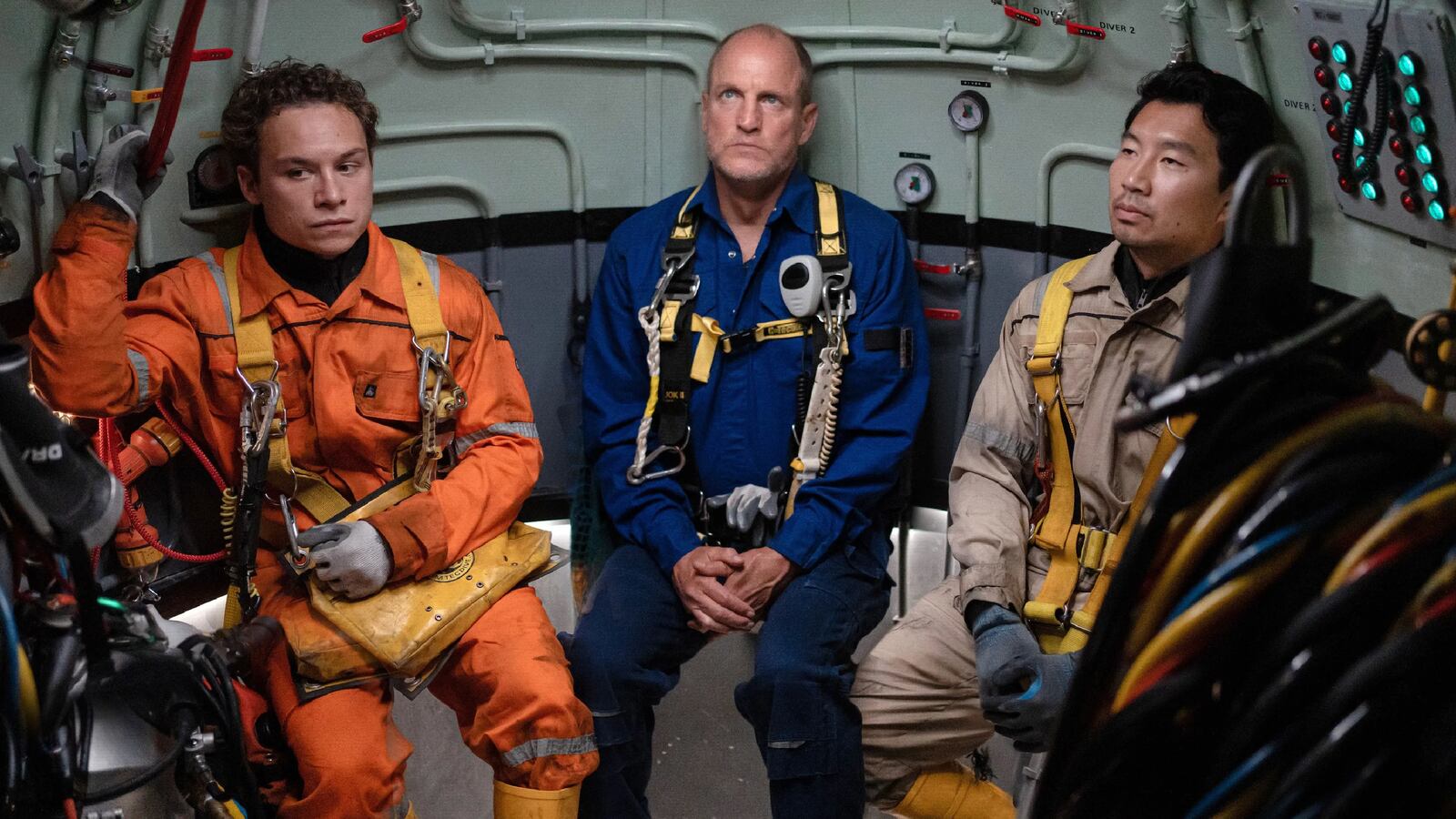Movies have the thrilling capacity to take us to other worlds, but they’re also capable of depicting parts of our own that we neither know nor see, and that may be the most compelling aspect of Last Breath.
Directed by Alex Parkinson, whose 2019 documentary of the same name serves as its basis, this true-life story concerns “saturation divers,” the courageous deep-sea aquamen who maintain the 20,000 miles of pipes that line the ocean floor. They’re a rare breed whose work goes largely unnoticed, and not simply because it’s carried out at depths where light struggles to survive, and Parkinson’s drama brings their toil to gripping (if slightly shallow) life, all via a tale about a mishap that was overcome through teamwork, bravery, and more than a bit of miraculous luck.
In Aberdeenshire, Scotland, Chris Lemons (Peaky Blinders’ Finn Cole) says goodbye to his fiancé Morag (Bobby Rainsbury) at their coastal trailer home, which they plan to replace in short order with a house. Unsurprisingly, Morag doesn’t love Chris’ profession, regardless of the fact that he thinks it’s like going into space (“but underwater”) and thus is “pretty cool.”
Chris subsequently reports for duty at a North Sea diving station, greeting various crew members as he makes his way through and across the enormous support vessel that’ll transport him to his destination. Of particular note among those comrades is Duncan Allock (Woody Harrelson), a mentor who asks him what color Chris and Morag plan to paint “his” room in their new residence—only to jokingly hear that it’ll be a fine shade of pink.
Chris and Duncan are commanded by supervisor Craig (Mark Bonnar), and they’re additionally partnered with Dave Yuasa (Simu Liu), who greets Chris—a relative rookie at this vocation—with standoffish gruffness. Together, the trio is housed in a giant pill-shaped “tin can” for days to decompress in preparation for their real task, and if the entrance to this structure not-so-subtly resembles an anus, that’s fitting for an undertaking that’s about to thrust these men headfirst into the s---.
As their bodies acclimate, Craig watches videos from his beloved Morag, Dave exercises to heavy metal, and Duncan confesses that this is his last go-round, as he’s being “put out to pasture” after a successful 20-year career—a turn of events about which he’s not happy.
Parkinson (who co-wrote the script with Mitchell LaFortune and David Brooks) provides glimpses of complex equipment and audio snippets of technical jargon to set his scene, but he wisely doesn’t get bogged down in explaining the ins and outs of this complicated operation; instead, he correctly assumes that his action will speak for itself.
That it does, with Chris, Duncan, and Dave soon exiting their confines for even tighter quarters in a spherical “bell” that’s lowered beneath their ship by a rig. Exiting the bell via a hatch that opens to a platform “stage” and, below it, borderline-impenetrable darkness, Chris follows the more experienced Duncan’s lead. Both are kept alive by a heavy metal helmet and oxygen tanks, and they’re tethered to the bell by an “umbilical” cord. Their target: a manifold of gas wells that they intend to inspect and, if necessary, repair.
While Chris and Dave embark on their journey, Duncan waits in the bell, managing their cords. On the surface, Craig watches them carry out their job via helmet cameras, and though things initially go smoothly, that all changes when the support vessel—overseen by Captain Andre Jensen (Cliff Curtis)—suddenly and inexplicably goes on the fritz, its dynamic positioning system (which allows it to maintain its location) failing.
This would be a big problem in any circumstance, and in this case, it’s a disaster, since a raging storm is producing enormous swells that are causing the vessel to drift. Realizing that they’re suddenly in grave danger, Chris and Dave attempt to exit the manifold so they can safely return to the bell. Unfortunately, due to a snag, Chris’ cord gets stuck on the structure, and ultimately snaps, leaving him stranded on the bottom of the ocean with no way of getting topside and less than 10 minutes of breathable backup oxygen.
From that moment, Last Breath becomes a race against time to reach Chris, and Parkinson conveys the urgency of this situation both through on-screen countdowns and via a canny interplay of light and dark, silence and noise. It’s not long before Chris is out of air, at which point the film further tightens the screws. Still, a hindrance to the material’s tension is a narrative that often veers from concise to slight.
Although this incident is undeniably harrowing, it’s rather straightforward, and an absence of twists (or even secondary obstacles) neuters some of its suspense, keeping everything at a reasonably taut pitch that never quite elicits the edge-of-your-seat anxiety it aims to generate.
Last Breath is less substantial than Ron Howard’s Thirteen Lives (also based on a real watery calamity), to the point that it almost struggles to fill out its 93-minute runtime. Nonetheless, Harrelson, Liu, and Cole make the most of their sketchy characters, infusing them with just enough personality to overshadow their relatively slender construction (regardless of cursory backstory details).
Better yet, Parkinson keeps the pedal to the metal so that even without a series of cascading problems, the film maintains a requisite amount of unease. Underwater cinematography courtesy of Ian Seabrook (some of it in grainy black and white) adds to the oppressive mood, immersing us in a universe of consuming, imposing murk.
Most amazing of all is Last Breath’s conclusion, which would resonate as wholly unbelievable—and the sort of happily-ever-after claptrap that Hollywood adores—if it weren’t true. Parkinson’s coda can merely theorize about how this all turned out as well as it did, and his closing documentary footage of a joyous wedding and ensuing dive conveys the bonds of brotherhood forged by this traumatic catastrophe.
As a window into a foreign world of dangerous aquatic maintenance, Parkinson’s fictional feature debut is eye-opening. What ultimately lingers more, however, is its portrait of the grit, determination, and sacrifice exhibited by these individuals—a stirring reminder that there’s nothing more noble than having your fellow man’s back.









